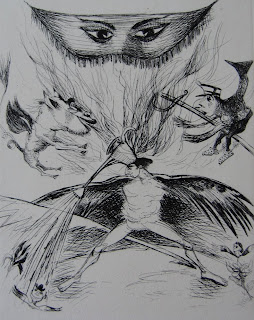Each etching is signed, justified and titled in pencil, but low down the sheet rather than directly below the image. The etchings are printed on Hollande van Gelder wove paper, presumably by the artist himself, as no printer is mentioned.
These etchings look beyond the modish self-regard of the Surrealists to locate the surreal in a long artistic tradition. There are touches in them of the grotesqueries of Hieronymous Bosch, the absurd animal/human hybrids of J.J. Grandville, even the fairy fantasies of Richard Doyle. But the artist they reference most is the one André Villeboeuf revered above all others: Francisco Goya. In 1799 Goya published a sequence of 80 etchings entitled Caprichos, which use elements of the supernatural and the surreal to satirize society's injustices. All 80 Caprichos can be seen here; they get weirder as the series progresses. André Villeboeuf didn't call his portfolio Caprices - he probably felt it would be ridiculously self-aggrandizing - but the debt to Goya is clear in this sequence of startling and unsettling visions. I'll let the images speak for themselves.
André Villeboeuf
Lubies no. 1: Canicule
Etching, 1934
André Villeboeuf
Lubies no. 2: Vol à voile
Etching, 1934
André Villeboeuf
Lubies no. 3: Cavalerie noire
Etching, 1934
André Villeboeuf
Lubies no. 4: Nuit de Chine
Etching, 1934
André Villeboeuf
Lubies no. 5: Torticolis
Etching, 1934
André Villeboeuf
Lubies no. 6: Idylle sous-marine
Etching, 1934
André Villeboeuf
Lubies no. 7: Gilles de Binche
Etching, 1934
André Villeboeuf
Lubies no. 8: Passion dévorante
Etching, 1934
André Villeboeuf
Lubies no. 9: Eloquence
Etching, 1934
André Villeboeuf
Lubies no. 10: Le retour du poilu
Etching, 1934
André Villeboeuf
Lubies no. 11: Comédie-française
Etching, 1934
André Villeboeuf
Lubies no. 12: Stratèges
Etching, 1934
André Villeboeuf
Lubies no. 13: La Mandragore
Etching, 1934
André Villeboeuf
Lubies no. 14: Général, la victoire vous sourit!
Etching, 1934
André Villeboeuf
Lubies no. 15: La Sainte-Hubert
Etching, 1934
André Villeboeuf
Lubies no. 16: Le coup de grâce
Etching, 1934








































